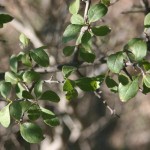Elbowbush
Forestiera angustifolia
Oleaceae
Description
This evergreen shrub, also known as Desert Olive, has smooth grey bark and is about 3 to 8 ft or 1 to 2.5 m in height. Its branches are at 90 degree-angles coming off the main stem opposite each other-hence, the common name Elbowbush. It is densely and intricately branched; young branches are black. The leaves, clustered on the mature twigs, are smooth, light green, and linear with entire margins. On young shoots, the leaves are mostly opposite. They are leathery and somewhat revolute (rolled toward the underside) with obscure veins running about half a centimeter wide and 3 centimeters long. The inconspicuous greenish-yellow flowers emerge in clusters right before new leaves sprout or in the spring. The dioecious flowers lack petals and have conspicuously exerted stamens bearing reddish-brown anthers. Elbowbush's fruit is a small, black, single-seeded drupe oblong-oval shaped and about one centimeter. It is commonly grazed by both white-tailed deer and livestock and the fruit is eaten by numerous small mammals and birds. Because the flowers bloom early, they are an important source of nectar for bees early in the year.Habitat
Elbowbush is commonly found on dry, well-drained, and stony hillsides of the Rio Grande Plains and Trans-Pecos regions and along the gulf as far east as Chambers County. It has a high heat tolerance and prefers full sun. Richard Taylor in Common Woody Plants & Cacti of South Texas provides a personal communication that Elbowbush “increased rapidly in chaparral communities on clay soils along the central coastal prairies [since 2000].”Images
Plant Characteristics
Flower Color: Green, Yellow
Seed Type: Drupe
Duration: Perennial
Stem Texture: Hairless/Smooth
Growth Habit: Shrub (Woody)
Leaf Shape
 : Simple with Pinnate or Parallel Venation
: Simple with Pinnate or Parallel Venation
Season: Warm
Distribution
 : 02 - Gulf Prairies and Marshes, 05 - Cross Timbers and Prairies, 06 - South Texas Plains, 07 - Edwards Plateau, 09 - High Plains, 10 - Trans-Pecos
: 02 - Gulf Prairies and Marshes, 05 - Cross Timbers and Prairies, 06 - South Texas Plains, 07 - Edwards Plateau, 09 - High Plains, 10 - Trans-Pecos
Distributions
Distribution refers to the ecological region in Texas that a plant has been found. You can also view a clickable map.
Collection: Brush and Weeds




